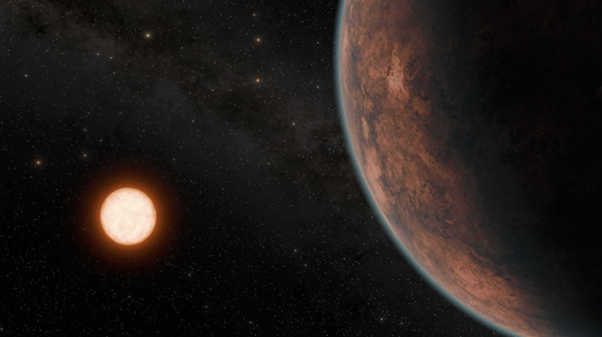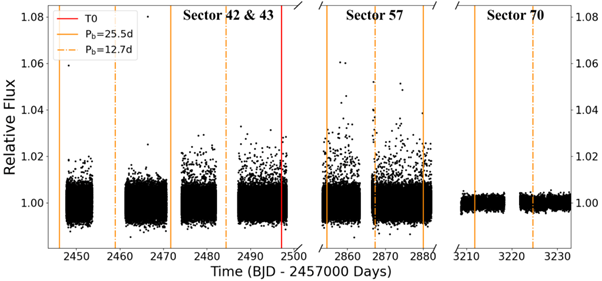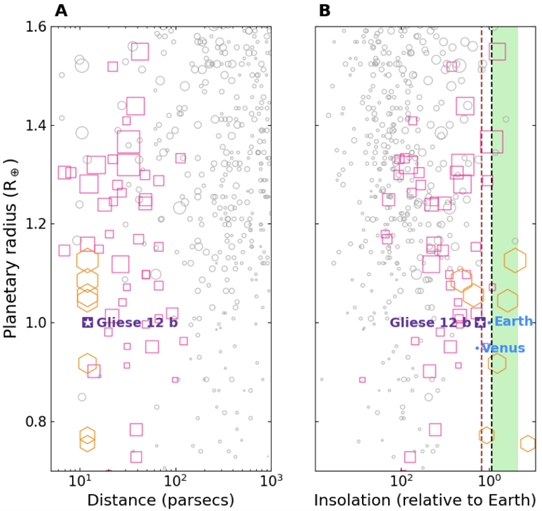CEH Blog
Welcome to the Centre for Exoplanets and Habitability blog
In this irregular blog, members of the CEH will post short articles about interesting research relating to some aspect of habitability, whether that's their own work or just something that's caught their eye. Notification of new blog articles will be distributed via the CEH mailing list.
University of Warwick scientists have discovered an Earth-sized, Earth-temperature planet only 40 lightyears away

Figure 1: Artist impression of Gliese 12 and its orbiting Earth-like planet.
The search for life and understanding the habitability of planets begins with their discovery. In recent years instrumental breakthroughs have allowed for the discovery of small, rocky bodies that could be similar to the Earth. This then permits detailed analyses of their interiors and atmospheres to provide a better insight into their habitability.
Gliese 12 is a cool, small, nearby M-dwarf type star with a mass and radius a quarter of the Sun. This means that it has an effective temperature of roughly 3200 K, compared to the Sun’s 5770 K. With an age of ~7 Gyr, Gliese 12 is older than the Sun and due to this old age it has a lower iron content than the Sun. However, the star lies only 40 lightyears away making it an exciting target to study.
NASA’s TESS (Transiting Exoplanet Survey Satellite) observed Gliese 12 in 2021 in its 42nd and 43rd Sectors of data, see Figure 2. A transit, the drop in light we receive from a star when an object passes between it and us, was found indicating that a planet could be orbiting this star. Additional TESS data taken in 2022 in Sector 57 showed another two transits, however due to observational gaps it wasn’t clear if the orbital period (i.e. year) of the planet candidate was 12.7 or 25.5 days. This distinction is important as it can drastically change the temperature of the planet.

Figure 1: TESS data of Gliese 12 with the original transit detection highlighted in red, and transits of other periods shown in orange (Dholakia, Palethorpe, ... Wilson, et al., 2024)
To confirm the presence of the planet and determine its true orbital period, Dholakia, Palethorpe,... Wilson, et al. (2024) obtained additional transit data using the European Space Agency’s (ESA) CHEOPS (CHaracterising ExOPlanets Satellite) telescope, see Figure 3. By only observing Gliese 12 at specific times with CHEOPS and using new TESS Sector 70 data, the team were able to determine that the planet (now named Gliese 12 b) is real and orbits its host star every 12.7 days.

Figure 2:Transits of Gliese 12 b observed with the TESS and CHEOPS space telescopes (Dholakia, Palethorpe, ... Wilson, et al., 2024).
From a detailed analysis of all transit data, Dholakia, Palethorpe,... Wilson, et al. (2024) found that Gliese 12 b has the same radius as our own Earth (Rp = 1.0+/-0.1 REarth) and a planetary equilibrium temperature of 42C (Teq = 315+/-5 K). This makes Gliese 12 b the closest Earth-sized and Earth-temperature planet known! Figure 4A shows the radius of and distance to this new planet compared to other known planets, whereas Figure 4B plots the planet radius against insolation, the amount of light received by planets from their host star.

Figure 3: The planet radius, distance, and insolation of Gliese 12 b (purple) placed in context with Venus and Earth (blue), the TRAPPIST-1 system (orange), other M-dwarf planets (pink), and all known exoplanets (grey). The M-dwarf habitable zone is shown in green (Dholakia, Palethorpe, ... Wilson, et al., 2024).
Intriguingly, this means that Gliese 12 b receives a similar amount of light as Venus, whilst being the same size as the Earth. Given that the host star is brighter than the famous TRAPPIST-1, this makes this planet one of the best targets for future atmospheric and internal structure characterisation.
With ongoing programmes to measure the mass of Gliese 12 b, we will soon find out how similar this new planet is to the Earth and Venus, and discover how habitable this “Earth-like” planet truly is!
Learn more in the paper (https://arxiv.org/pdf/2405.13118Link opens in a new window) and Warwick press release (https://warwick.ac.uk/newsandevents/pressreleases/gliese12bLink opens in a new window).
